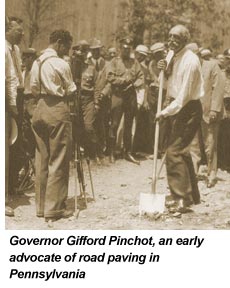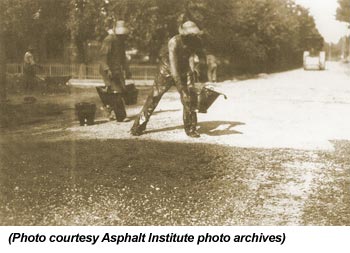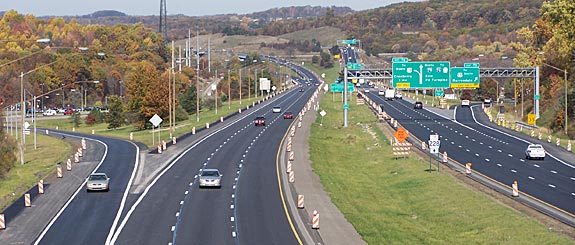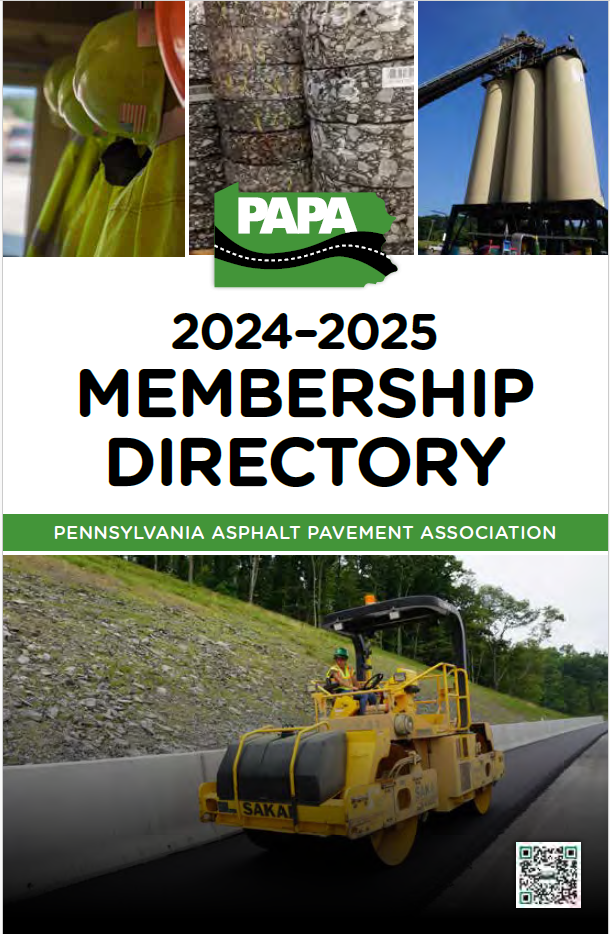History of the Pennsylvania Asphalt Pavement Association
Pennsylvania Asphalt Pavement Association (PAPA), the recognized and respected voice of the Pennsylvania asphalt pavement industry. Our mission is to promote and provide to our customers the best available asphalt pavement technology and to represent and serve the common interests of its members. Further details about the Association's goals can be found in the Strategic Plan.

In 2007, the Pennsylvania Asphalt Pavement Association proudly marked 75 years of technical and industrial progress.
This milestone was reached through the industry’s determination to improve its product, technology, and shared knowledge. Through its seven decades, PAPA has often lead the nation in research, innovation, and initiative toward providing the quality of bituminous concrete products needed to attain the highway mobility we all require.
 In 1932, the Depression smothered the country. In that year, southeastern Pennsylvania representatives of six cold-mix bituminous concrete manufacturing operations began moving toward recovery. They discussed forming an association to band together to get their part of the industry growing again. Subsequently, on July 1, 1932, the Bituminous Concrete Association (BCA) was chartered.
In 1932, the Depression smothered the country. In that year, southeastern Pennsylvania representatives of six cold-mix bituminous concrete manufacturing operations began moving toward recovery. They discussed forming an association to band together to get their part of the industry growing again. Subsequently, on July 1, 1932, the Bituminous Concrete Association (BCA) was chartered.
The initial efforts of BCA were directed toward working with the Pennsylvania Department of Highways in establishing attainable product standards for maintenance and construction work. However, as the National Recovery Administration (NRA) emerged in Washington and began the push to re-establish the economy from a federal level, BCA expanded to become a statewide association with more clout. By 1934, the Bituminous Concrete Association’s officers functioned as regional code authority for the Cold Laid Bituminous Concrete Division of the Crushed Stone, Sand and Gravel, and Slag Industries.
 Through the 1930s, under the presidency of Colonel George H. Bunker, then president of Interstate Amiesite Corporation, BCA expanded its national influence by providing technical data and wage and hour recommendations to various levels of the NRA structure in Washington.
Through the 1930s, under the presidency of Colonel George H. Bunker, then president of Interstate Amiesite Corporation, BCA expanded its national influence by providing technical data and wage and hour recommendations to various levels of the NRA structure in Washington.
During this time the Bituminous Concrete Association had created the Technical Committee, whose function was to conduct tests and research to improve products and manufacturing methods. The Technical Committee later developed a program of endowments to Bucknell and Pennsylvania State Universities for the creation of testing laboratories, and the establishment of annual bituminous concrete industry conferences at which the latest advancements, technology, and future problems were explored.
As the 1940s began, the bituminous concrete industry in Pennsylvania appeared to be on a strong upward growth trend. Then World War II changed the trend. Asphalt shortages and critical demands on railroad transportation hit the industry. BCA’s technical work expanded in an attempt to hold its share of the market.
With the close of the war, the momentum that had carried BCA through turbulent times began to slow down, until 1949, when a mood of revitalization took hold. BCA became the Bituminous Concrete Association of Pennsylvania in 1949.
Within the next eight years, BCA of Pennsylvania pushed harder to advance its industry. Research projects included investigation of sampling methods and extraction tests of hot mixed, hot-laid bituminous concrete; various aggregate samplings and tests; and comparisons of materials and workmanship quality.
 During the first 25 years of BCA’s history, Harlan Conly served as Secretary-Treasurer. The first full-time Executive Secretary, John S. Spangler, was hired in 1959 and served until 1964. In 1964 the Association hired Warren Myers, who served from 1964 to 1966. At the end of 1966, the new Executive Director was Edward J. Siodlowski, who served the Association until January 1984. Mr. Carl W. Lubold, Jr., was appointed Executive Director, February 1984, and served until September 1996. In September 1996, Mr. Ronald J. Cominsky, P.E., was appointed Executive Director and served through 2009. Mr. Gary L. Hoffman, P.E., was appointed Executive Director in December 2009 and served through May 2015. Mr. Charlie C. Goodhart was hired in June 2015 and currently serves as Executive Director.
During the first 25 years of BCA’s history, Harlan Conly served as Secretary-Treasurer. The first full-time Executive Secretary, John S. Spangler, was hired in 1959 and served until 1964. In 1964 the Association hired Warren Myers, who served from 1964 to 1966. At the end of 1966, the new Executive Director was Edward J. Siodlowski, who served the Association until January 1984. Mr. Carl W. Lubold, Jr., was appointed Executive Director, February 1984, and served until September 1996. In September 1996, Mr. Ronald J. Cominsky, P.E., was appointed Executive Director and served through 2009. Mr. Gary L. Hoffman, P.E., was appointed Executive Director in December 2009 and served through May 2015. Mr. Charlie C. Goodhart was hired in June 2015 and currently serves as Executive Director.
Harlan Conly 1959 – 1964
Warren Myers 1964 – 1966
Edward J. Siodlowski 1966 – 1983
Carl W. Lubold, Jr., P.E. 1984 – 1996
Ronald J. Cominsky, P.E. 1997 – 2009
Gary L. Hoffman, P.E. 2009 - 2015
Charles C. Goodhart 2015 - present
At the close of the 1950s, the Association was actively engaged in developing specifications for architects, consulting engineers, and local road and street departments, as well as developing a plant safety program and a drive for expanded membership.
The Association entered its third decade by beginning its District Visitation Program through which members and Highway Department personnel developed important dialogue in the field. It also launched its annual Bituminous Concrete Highway Conferences, released its first Design Manual, and expanded its program of promotion for the use of asphalt for the primary, secondary, county, and local road programs.
In the second half of the 1960s, relative tranquility collapsed. Highway cutbacks were announced due to lack of funds – a new breed of political activists appeared in America – the environmentalist. Cleaner water and air along with less noise “pollution” was the focus of the day.
And still to come was the impact of OSHA regulations. Work moved forward to assist members to comply with the avalanche of regulations and to reasonably resist and change those which were most unreasonable or unfeasible.
Work also moved forward to expand the use and acceptance of our product. Thick lift testing was conducted and coordinated with the Department of Highways. Total asphalt depth was conceived and promoted. Skid resistance testing was initiated as an association program.
At the Association’s annual meeting in December 1969, the Bituminous Concrete Association of Pennsylvania adopted its present identity as the Pennsylvania Asphalt Pavement Association.
The attention of the Association in the early 1970s continued toward the advancement of technology and uniformity of specifications and equipment regulations.
More especially, however, efforts were increased to obtain relief for the industry from the severe hardships caused by the Air Pollution Code, specifically Regulation IV. And the energy crunch began. An asphalt supply shortage set in. It looked like the 1970s would be filled with challenges and problems as severe to the industry as those faced in the 1930s and 1940s. But Association efforts gained results.
 Through the late 1980s and 1990s, The Association worked with the now Department of Transportation in Pennsylvania to implement pavement smoothness goals and the SUPERPAVE hot asphalt mix design system. Pennsylvania was a leader in promoting and adopting the International Roughness Index (IRI) as a consistent way of measuring smoothness. The establishment of smoothness requirements in contracts with incentive/disincentive payouts greatly increased focus on smoothness and led to increased use of hot mix asphalt pavements. The SUPERPAVE design system, one of the primary products of the national Strategic Highway Research Program (SHRP), was implemented over a period of about ten years. This new design system abated the severe truck tire pressure-induced rutting seen in the late 1980s.
Through the late 1980s and 1990s, The Association worked with the now Department of Transportation in Pennsylvania to implement pavement smoothness goals and the SUPERPAVE hot asphalt mix design system. Pennsylvania was a leader in promoting and adopting the International Roughness Index (IRI) as a consistent way of measuring smoothness. The establishment of smoothness requirements in contracts with incentive/disincentive payouts greatly increased focus on smoothness and led to increased use of hot mix asphalt pavements. The SUPERPAVE design system, one of the primary products of the national Strategic Highway Research Program (SHRP), was implemented over a period of about ten years. This new design system abated the severe truck tire pressure-induced rutting seen in the late 1980s.
As in the beginning, PAPA continues to pursue its goals: achieving a high level of quality products, fostering excellent communication and cooperation with owner and regulatory agencies and with its companion trade associations, promoting with the public and transportation committees at the national, state and local levels of government to obtain adequate funding for the highway infrastructure, and maintaining the integrity and sustainability of this vital industry.
Throughout its history, the strength of PAPA has been its broad membership speaking as one respected “voice” to lead in attaining these goals.

